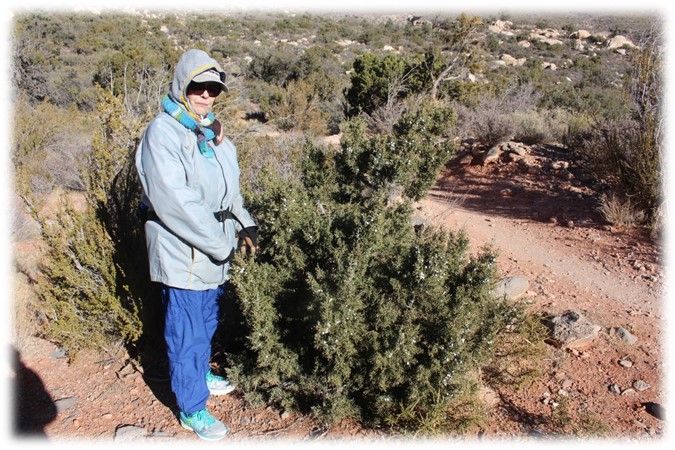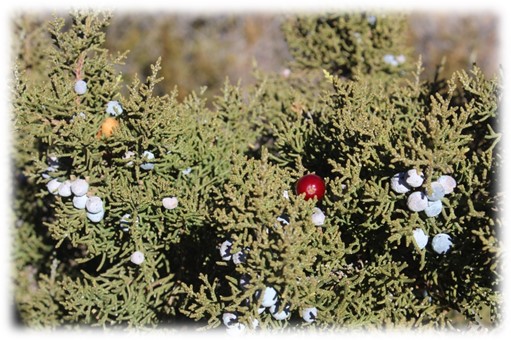
Gail and I are about half hour’s drive away from the Red Rock Canyon National Conservation Area in southern Nevada, just west of Las Vegas. As you can see by Gail’s coat and hoody, it does get cold in southern Nevada this time of year, even with global warming. But this was December 21, Winter Solstice. Cold is 50 degrees to folks who live here year round and manage to endure 115 degree desert heat as normal during the summer. The 200,000 acres that make up the National Conservation area, now administered by the Bureau of Land Management, is an enchanting escape from the crunch of 2 million people now living in the Las Vegas basin. Up here, a thousand feet above the city, one can hear the silence, see the lack of human presence, smell the freshness of nothing but nature – with a hint of juniper, sage and even a suggestion of creosote.
On or around Winter Solstice, a significant measurable time and place as we travel around our Sun, we acknowledge the grandeur of existence. We interrupt our daily routine and ponder our human awareness of where we are in the vast Universe. Using today’s evidence-based Universe story, we now have a sense of how we got here. By getting outdoors and literally touching nature, we can better embrace our science-based creation story.
For the past 7 years, we have honored a small personal tradition at the Park. From the entrance, we drive about half way around the Red Rock Scenic Loop (6 miles) to the Lost Creek parking area. Across the road from the parking, we find an easy walking trail that links up with the White Rock Hills Loop trail and we head northeast. This hike is considered a trek through the transition zone between the Blackbush shrub and Pinyon-Juniper woodland.
As we were ascending the gentle path up the southern side of the first hillside early in the morning, the sun was still low in the cloudless sky and providing a unique back-light that reflected off the spines of the many scattered cholla cactus. To the eye, the prickly spines were transformed into a furry white yellow glow surrounding each of the branching stems of these tenacious desert characters. This was one of those golden visual moments you often see in the wild.
After a few switch backs to reach the top of the hillside, we traversed the top of the ridge and then followed the trail back down the other side. Just before heading down the backside, I look back at a similar ridge to the south. It was like looking in a mirror. The vegetation on that ridge was identical to the one we were walking on, but from a distance I could see that the entire surface of that ridge was covered with a blanket of life. Between the green sage and other perennial shrubs laid a continuous tan blanket of grasses and other ground cover plants now dormant for the winter. This is the Mohave Desert, with a meager 6-10 inches of rainfall each year, yet evolving life has found species to capture every drop of moisture and harvest every flicker of sunlight available. The tenacity of life on planet Earth is beyond awesome.
This is a land of red sandstone, and gray limestone, slowly eroding to become new soil and home of a diverse array of living systems – over 600 species of plants ( including banana yucca, Morman tea, and Buckhorn Cholla cactus) and 300 species of animals (over the years we’ve seen the obvious large mammals: desert bighorn sheep, mule deer, desert cottontail, black-tailed jackrabbits and wild burros.)
After about ½ hour of hiking, we were now among the Blackbush, Creosote, and Juniper that have found a niche with the red rock outcroppings. It’s like another world completely hidden from our starting point. Just a few steps off to the left of the trail, there it was – our destination – a small Juniper Gail “discovered” on Christmas Day 8 years ago.
This year our little Juniper was decked out in pale blue berries (I later learned the berry is a female seed cone with unusually fleshy and merged scales that give it a berry-like appearance.) Strange, but as we looked around, we noticed no other juniper within sight had berries, making our tree even more special.
 Not knowing what we humans can do to be mutually beneficial to our distant Juniper cousin, we try to bring goodwill and positive energy plus a few natural ‘ornaments’ for our celebration of life. This year Gail brought a small cottonwood twig that had been broken to display the ‘star’ within (but that’s another story) and placed it gently near the top of Juniper. I reached into my pocket for my ‘ornaments’ this year – cranberries and mixed nuts – and placed them carefully within the Juniper’s needles.
Not knowing what we humans can do to be mutually beneficial to our distant Juniper cousin, we try to bring goodwill and positive energy plus a few natural ‘ornaments’ for our celebration of life. This year Gail brought a small cottonwood twig that had been broken to display the ‘star’ within (but that’s another story) and placed it gently near the top of Juniper. I reached into my pocket for my ‘ornaments’ this year – cranberries and mixed nuts – and placed them carefully within the Juniper’s needles.
There we were. Three unique piles of star stuff. Celebrating life. Two Human (homo sapien) beings and one Utah Juniper (juniperus osteosperma) being. All evidence-based distant cousins thanks to DNA sequencing and our current knowledge of the phylogenic tree of life on Earth. The three of us are made of the same star stuff and we have a common ancestor albeit 3-4 billion years ago – called LUCA — the Last Universal Common Ancestor. Knowing and acknowledging that all life on Earth is just one large extended family is one way to experience the feeling of a Merry Holiday. Touching Nature is knowing Truth – the antidote for the poison of human lies such as we endured this last trip around the Sun.
Before leaving, it seemed appropriate to sprinkle precious drops of the water remaining in my water bottle on Juniper – after all, communing with / touching nature is a spiritual moment. May we all have many.
No Comments